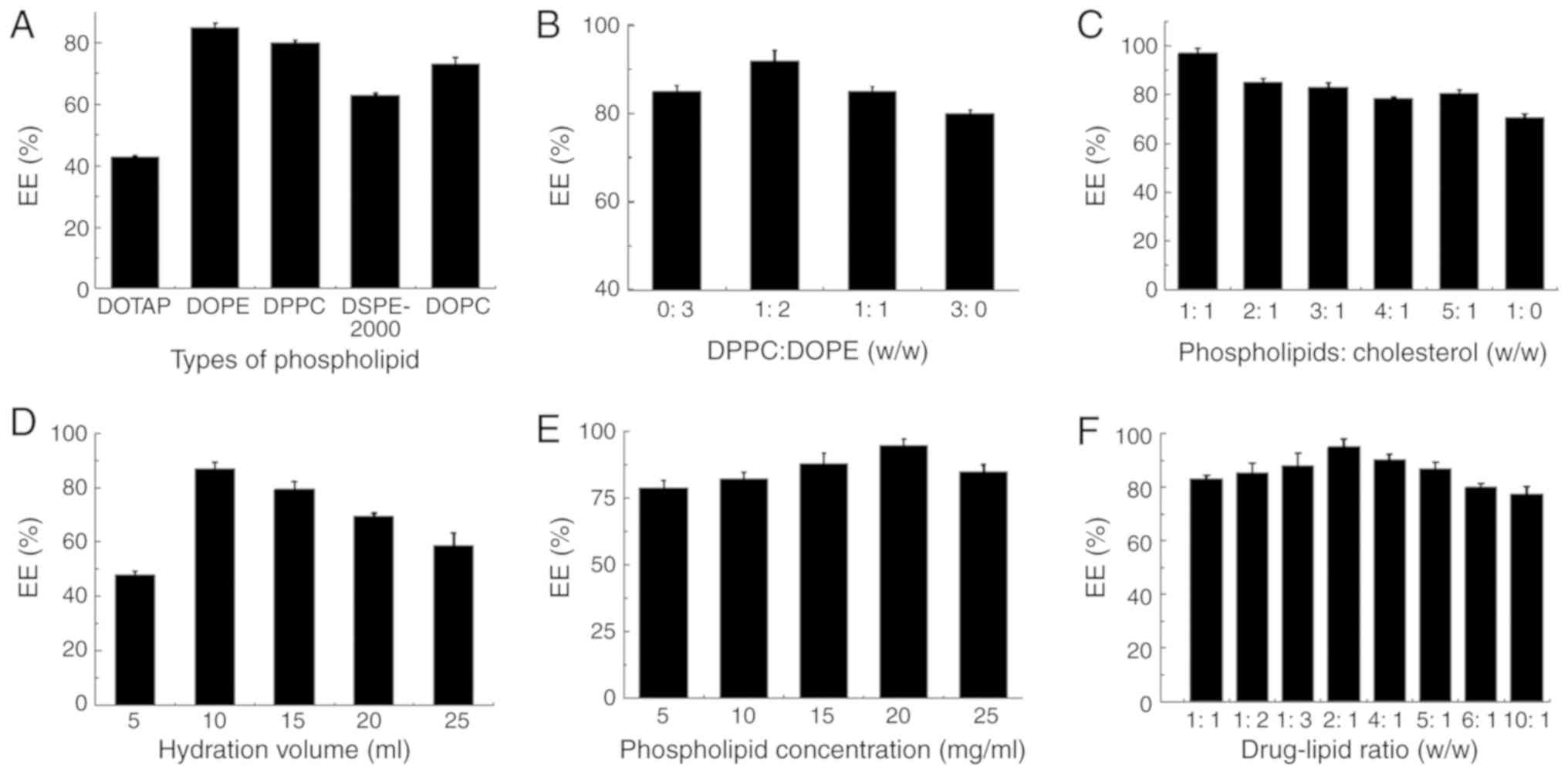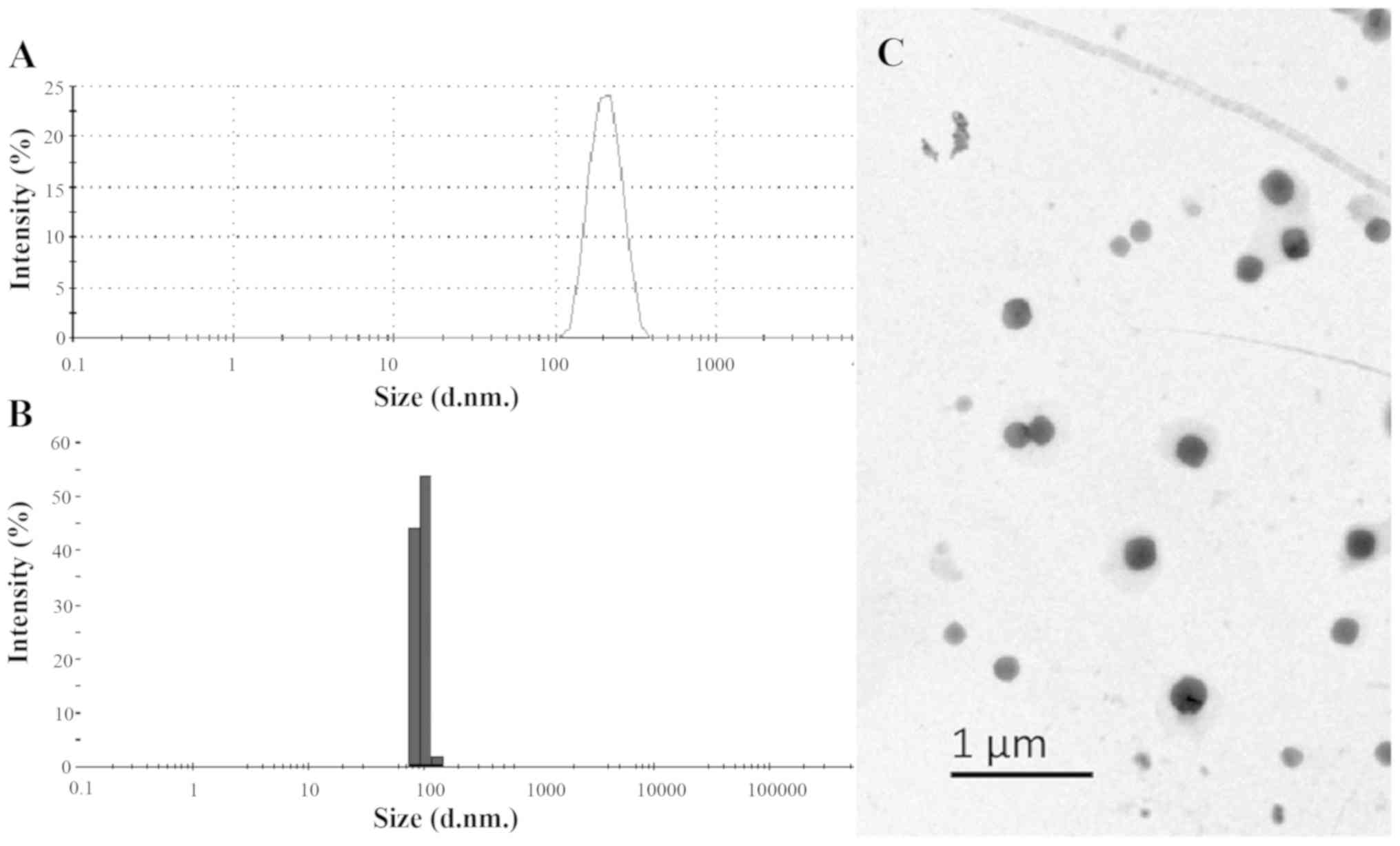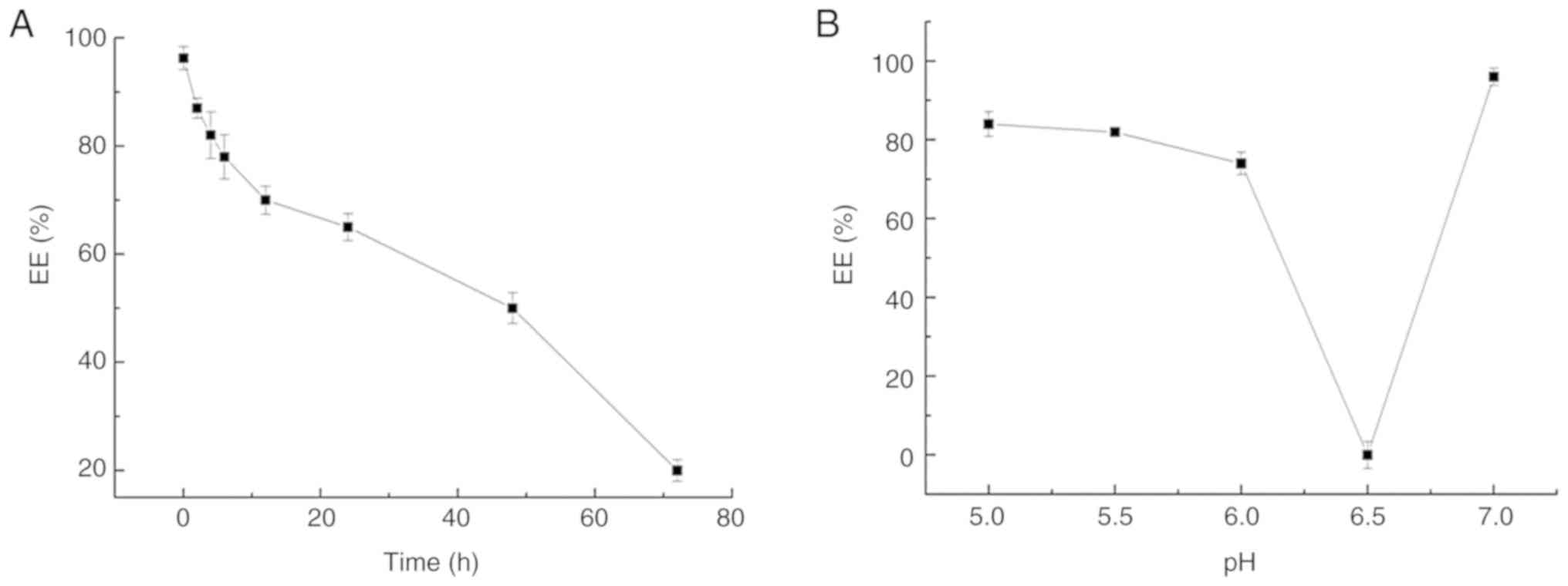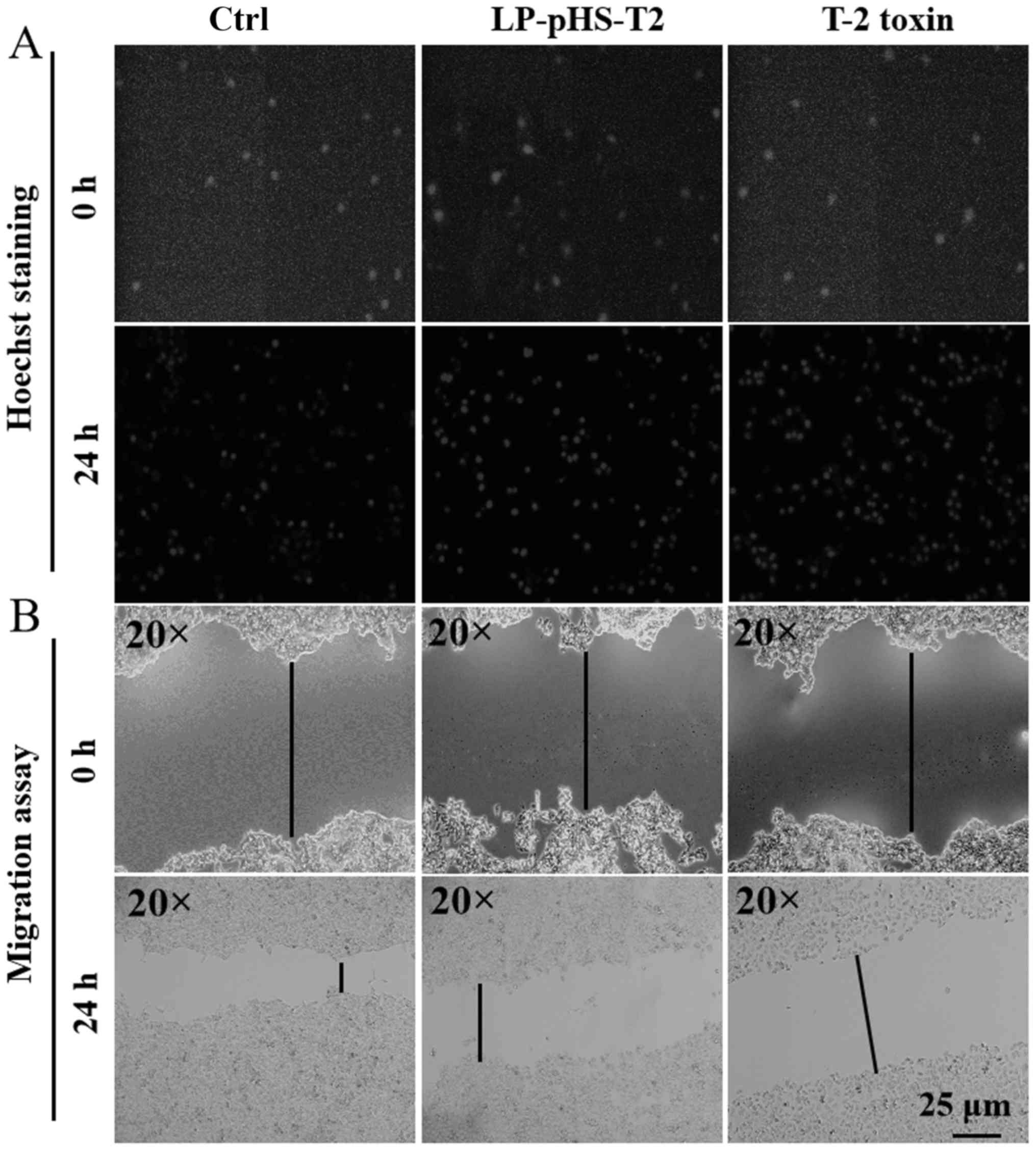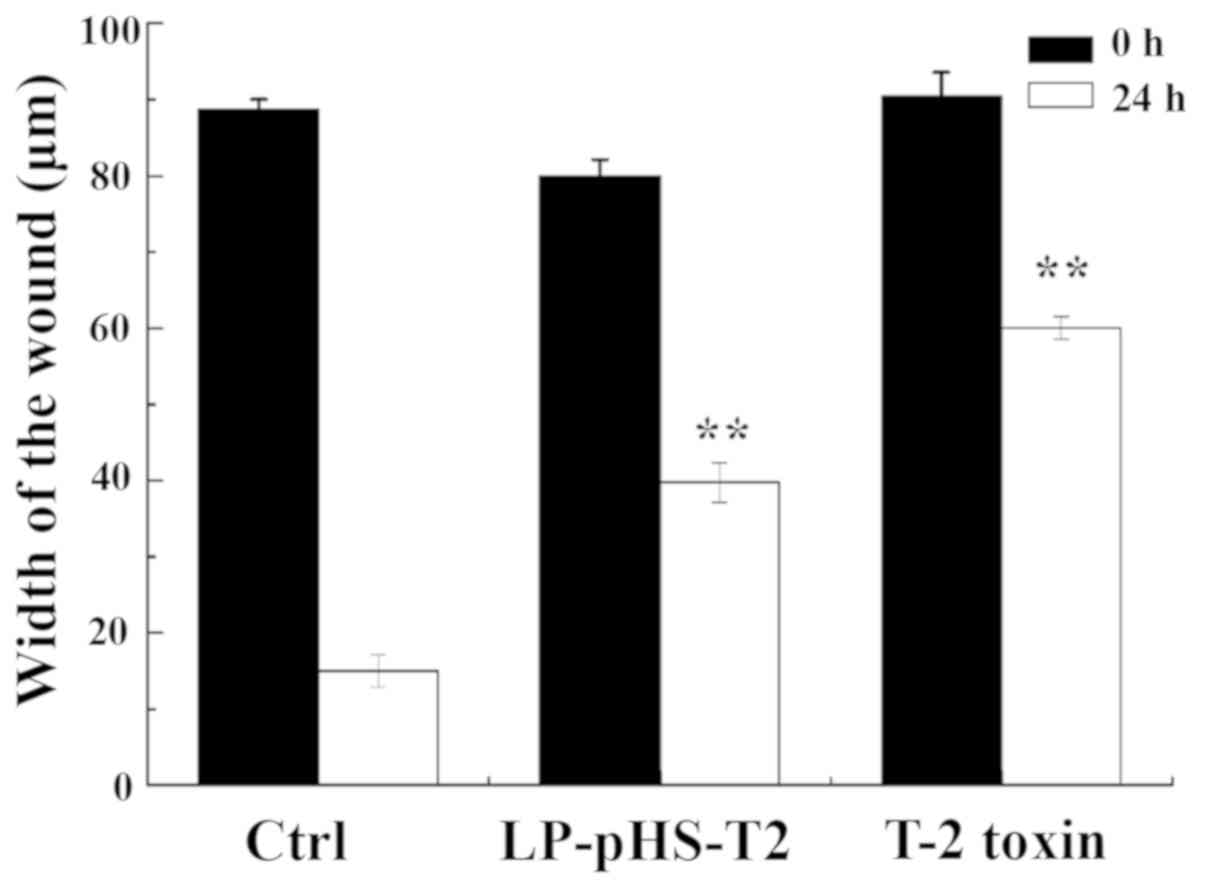|
1
|
Wu J, Zhou Y, Yuan Z, Yi J, Chen J, Wang N
and Tian Y: Autophagy and apoptosis interact to modulate T-2
toxin-induced toxicity in liver cells. Toxins (Basel). 11:452019.
View Article : Google Scholar
|
|
2
|
Yang L, Tu D, Wang N, Deng Z, Zhan Y, Liu
W, Hu Y, Liu T, Tan L, Li Y, et al: The protective effects of
DL-selenomethionine against T-2/HT-2 toxins-induced cytotoxicity
and oxidative stress in broiler hepatocytes. Toxicol In Vitro.
54:137–146. 2019. View Article : Google Scholar : PubMed/NCBI
|
|
3
|
Meng-Reiterer J, Varga E, Nathanail AV,
Bueschl C, Rechthaler J, McCormick SP, Michlmayr H, Malachova A,
Fruhmann P, Adam G, et al: Tracing the metabolism of HT-2 toxin and
T-2 toxin in barley by isotope-assisted untargeted screening and
quantitative LC-HRMS analysis. Anal Bioanal Chem. 407:8019–8033.
2015. View Article : Google Scholar : PubMed/NCBI
|
|
4
|
Wang Y, Zhang L, Peng D, Xie S, Chen D,
Pan Y, Tao Y and Yuan Z: Construction of electrochemical
immunosensor based on gold-nanoparticles/carbon nanotubes/chitosan
for sensitive determination of T-2 toxin in feed and swine meat.
Int J Mol Sci. 19:38952018. View Article : Google Scholar
|
|
5
|
Seeboth J, Solinhac R, Oswald IP and
Guzylack-Piriou L: The fungal T-2 toxin alters the activation of
primary macrophages induced by TLR-agonists resulting in a decrease
of the inflammatory response in the pig. Vet Res. 43:352012.
View Article : Google Scholar : PubMed/NCBI
|
|
6
|
Osselaere A, Li SJ, De Bock L, Devreese M,
Goossens J, Vandenbroucke V, Van Bocxlaer J, Boussery K, Pasmans F,
Martel A, et al: Toxic effects of dietary exposure to T-2 toxin on
intestinal and hepatic biotransformation enzymes and drug
transporter systems in broiler chickens. Food Chem Toxicol.
55:150–155. 2013. View Article : Google Scholar : PubMed/NCBI
|
|
7
|
Doi K, Ishigami N and Sehata S: T-2
toxin-induced toxicity in pregnant mice and rats. Int J Mol Sci.
9:2146–2158. 2008. View Article : Google Scholar : PubMed/NCBI
|
|
8
|
Fu YT, Lin WG, BaoCheng Z and Quan G: The
effect of T-2 toxin on IL-1beta and IL-6 secretion in human fetal
chondrocytes. Int Orthop. 25:199–201. 2001. View Article : Google Scholar : PubMed/NCBI
|
|
9
|
Chen X, Xu J, Liu D, Sun Y, Qian G, Xu S,
Gan F, Pan C and Huang K: The aggravating effect of selenium
deficiency on T-2 toxin-induced damage on primary cardiomyocyte
results from a reduction of protective autophagy. Chem Biol
Interact. 300:27–34. 2019. View Article : Google Scholar : PubMed/NCBI
|
|
10
|
Huang Z, Wang Y, Qiu M, Sun L, Liao J,
Wang R, Sun X, Bi S and Gooneratne R: Effect of T-2 toxin-injected
shrimp muscle extracts on mouse macrophage cells (RAW264.7). Drug
Chem Toxicol. 41:16–21. 2018. View Article : Google Scholar : PubMed/NCBI
|
|
11
|
Nathanail AV, Varga E, Meng-Reiterer J,
Bueschl C, Michlmayr H, Malachova A, Fruhmann P, Jestoi M, Peltonen
K, Adam G, et al: Metabolism of the fusarium mycotoxins T-2 toxin
and HT-2 toxin in wheat. J Agric Food Chem. 63:7862–7872. 2015.
View Article : Google Scholar : PubMed/NCBI
|
|
12
|
Wu Q, Huang L, Liu Z, Yao M, Wang Y, Dai M
and Yuan Z: A comparison of hepatic in vitro metabolism of T-2
toxin in rats, pigs, chickens, and carp. Xenobiotica. 41:863–873.
2011. View Article : Google Scholar : PubMed/NCBI
|
|
13
|
Konigs M, Mulac D, Schwerdt G, Gekle M and
Humpf HU: Metabolism and cytotoxic effects of T-2 toxin and its
metabolites on human cells in primary culture. Toxicology.
258:106–115. 2009. View Article : Google Scholar : PubMed/NCBI
|
|
14
|
Wang J, Yang C, Yuan Z, Yi J and Wu J: T-2
toxin exposure induces apoptosis in TM3 cells by inhibiting
mammalian target of rapamycin/serine/threonine protein
kinase(mTORC2/AKT) to promote Ca2+production. Int J Mol
Sci. 19:33602018. View Article : Google Scholar
|
|
15
|
Ueno Y, Umemori K, Niimi E, Tanuma S,
Nagata S, Sugamata M, Ihara T, Sekijima M, Kawai K, Ueno I, et al:
Induction of apoptosis by T-2 toxin and other natural toxins in
HL-60 human promyelotic leukemia cells. Nat Toxins. 3:129–137.
1995. View Article : Google Scholar : PubMed/NCBI
|
|
16
|
Nagase M, Alam MM, Tsushima A, Yoshizawa T
and Sakato N: Apoptosis induction by T-2 toxin: Activation of
caspase-9, caspase-3, and DFF-40/CAD through cytosolic release of
cytochrome c in HL-60 cells. Biosci Biotechnol Biochem.
65:1741–1747. 2001. View Article : Google Scholar : PubMed/NCBI
|
|
17
|
Chaudhari M, Jayaraj R, Bhaskar AS and
Lakshmana Rao PV: Oxidative stress induction by T-2 toxin causes
DNA damage and triggers apoptosis via caspase pathway in human
cervical cancer cells. Toxicology. 262:153–161. 2009. View Article : Google Scholar : PubMed/NCBI
|
|
18
|
Gao C and Zhang Y, Chen J, Wang T, Qian Y,
Yang B, Dong P and Zhang Y: Targeted drug delivery system for
platinum-based anticancer drugs. Mini Rev Med Chem. 16:872–891.
2016. View Article : Google Scholar : PubMed/NCBI
|
|
19
|
T S A, Shalumon KT and Chen JP:
Applications of magnetic liposomes in cancer therapies. Curr Pharm
Des. 25:1490–1504. 2019. View Article : Google Scholar : PubMed/NCBI
|
|
20
|
Paliwal SR, Paliwal R and Vyas SP: A
review of mechanistic insight and application of pH-sensitive
liposomes in drug delivery. Drug Deliv. 22:231–242. 2015.
View Article : Google Scholar : PubMed/NCBI
|
|
21
|
Shaban N, Abdel-Rahman S, Haggag A, Awad
D, Bassiouny A and Talaat I: Combination between taxol-encapsulated
liposomes and eruca sativa seed extract suppresses mammary tumors
in female rats induced by 7,12 dimethylbenz(α)anthracene. Asian Pac
J Cancer Prev. 17:117–123. 2016. View Article : Google Scholar : PubMed/NCBI
|
|
22
|
Cadinoiu AN, Rata DM, Atanase LI, Daraba
OM, Gherghel D, Vochita G and Popa M: Aptamer-functionalized
liposomes as a potential treatment for basal cell carcinoma.
Polymers (Basel). 11:15152019. View Article : Google Scholar
|
|
23
|
Yang Y, Yang X, Li H, Li C, Ding H, Zhang
M, Guo Y and Sun M: Near-infrared light triggered liposomes
combining photodynamic and chemotherapy for synergistic breast
tumor therapy. Colloids Surf B Biointerfaces. 173:564–570. 2019.
View Article : Google Scholar : PubMed/NCBI
|
|
24
|
Sadeghi N, Kok RJ, Bos C, Zandvliet M,
Geerts WJC, Storm G, Moonen CTW, Lammers T and Deckers R:
Hyperthermia-triggered release of hypoxic cell radiosensitizers
from temperature-sensitive liposomes improves radiotherapy efficacy
in vitro. Nanotechnology. 30:2640012019. View Article : Google Scholar : PubMed/NCBI
|
|
25
|
Odette WL, Payne NA, Khaliullin RZ and
Mauzeroll J: Redox-triggered disassembly of nanosized liposomes
containing ferrocene-appended amphiphiles. Langmuir. 35:5608–5616.
2019. View Article : Google Scholar : PubMed/NCBI
|
|
26
|
Li B, Li B, He D, Feng C, Luo Z and He M:
Preparation, characterization, and in vitro pH-sensitivity
evaluation of superparamagnetic iron oxide nanoparticle-
misonidazole pH-sensitive liposomes. Curr Drug Deliv. 16:254–267.
2019. View Article : Google Scholar : PubMed/NCBI
|
|
27
|
Chen Y, Du Q, Guo Q, Huang J, Liu L, Shen
X and Peng J: A W/O emulsion mediated film dispersion method for
curcumin encapsulated pH-sensitive liposomes in the colon tumor
treatment. Drug Dev Ind Pharm. 45:282–291. 2019. View Article : Google Scholar : PubMed/NCBI
|
|
28
|
Duan Y, Wei L, Petryk J and Ruddy TD:
Formulation, characterization and tissue distribution of a novel
pH-sensitive long-circulating liposome-based theranostic suitable
for molecular imaging and drug delivery. Int J Nanomedicine.
11:5697–5708. 2016. View Article : Google Scholar : PubMed/NCBI
|
|
29
|
Chiang NJ, Chao TY, Hsieh RK, Wang CH,
Wang YW, Yeh CG and Chen LT: A phase I dose-escalation study of
PEP02 (irinotecan liposome injection) in combination with
5-fluorouracil and leucovorin in advanced solid tumors. BMC Cancer.
16:9072016. View Article : Google Scholar : PubMed/NCBI
|
|
30
|
Rehman AU, Omran Z, Anton H, Mely Y, Akram
S, Vandamme TF and Anton N: Development of doxorubicin
hydrochloride loaded pH-sensitive liposomes: Investigation on the
impact of chemical nature of lipids and liposome composition on
pH-sensitivity. Eur J Pharm Biopharm. 133:331–338. 2018. View Article : Google Scholar : PubMed/NCBI
|
|
31
|
Riondel J, Jacrot M, Fessi H, Puisieux F
and Potier: Effects of free and liposome-encapsulated taxol on two
brain tumors xenografted into nude mice. In Vivo. 6:23–27.
1992.PubMed/NCBI
|
|
32
|
Rubio DP, Roa LG, Soto DA, Velasquez FJ,
Gregorcic NA, Soto JA, Martinez MC, Kalergis AM and Vasquez AE:
Purification and characterization of saxitoxin from mytilus
chilensis of southern chile. Toxicon. 108:147–153. 2015. View Article : Google Scholar : PubMed/NCBI
|
|
33
|
Shi R, Xu X, Wu J, Wang T, Li Y, Ma B and
Ma Y: Hydrophilic interaction chromatography-tandem mass
spectrometry based on an amide column for the high-throughput
quantification of metformin in rat plasma. RSC Adv.
5:101386–101392. 2015. View Article : Google Scholar
|
|
34
|
Zhang H: Thin-film hydration followed by
extrusion method for liposome preparation. Methods Mol Biol.
1522:17–22. 2017. View Article : Google Scholar : PubMed/NCBI
|
|
35
|
Liu GX, Fang GQ and Xu W: Dual targeting
biomimetic liposomes for paclitaxel/DNA combination cancer
treatment. Int J Mol Sci. 15:15287–15303. 2014. View Article : Google Scholar : PubMed/NCBI
|
|
36
|
Dornetshuber-Fleiss R, Heilos D, Mohr T,
Richter L, Sussmuth RD, Zlesak M, Novicky A, Heffeter P,
Lemmens-Gruber R and Berger W: The naturally born fusariotoxin
enniatin B and sorafenib exert synergistic activity against
cervical cancer in vitro and in vivo. Biochem Pharmacol.
93:318–331. 2015. View Article : Google Scholar : PubMed/NCBI
|
|
37
|
Song J, Wang Y, Teng M, Zhang S, Yin M, Lu
J, Liu Y, Lee RJ, Wang D and Teng L: Cordyceps militaris induces
tumor cell death via the caspase-dependent mitochondrial pathway in
HepG2 and MCF-7 cells. Mol Med Rep. 13:5132–5140. 2016. View Article : Google Scholar : PubMed/NCBI
|
|
38
|
Ovejero S, Ayala P, Malumbres M,
Pimentel-Muinos FX, Bueno A and Sacristan MP: Biochemical analyses
reveal amino acid residues critical for cell cycle-dependent
phosphorylation of human Cdc14A phosphatase by cyclin-dependent
kinase 1. Sci Rep. 8:118712018. View Article : Google Scholar : PubMed/NCBI
|
|
39
|
Belwal VK and Singh KP:
Nanosilica-supported liposome (protocells) as a drug vehicle for
cancer therapy. Int J Nanomedicine. 13:125–127. 2018. View Article : Google Scholar : PubMed/NCBI
|
|
40
|
Soema PC, Willems GJ, Jiskoot W, Amorij JP
and Kersten GF: Predicting the influence of liposomal lipid
composition on liposome size, zeta potential and liposome-induced
dendritic cell maturation using a design of experiments approach.
Eur J Pharm Biopharm. 94:427–435. 2015. View Article : Google Scholar : PubMed/NCBI
|
|
41
|
Zhang X, Wang Y, Velkov T, Tang S and Dai
C: T-2 toxin-induced toxicity in neuroblastoma-2a cells involves
the generation of reactive oxygen, mitochondrial dysfunction and
inhibition of Nrf2/HO-1 pathway. Food Chem Toxicol. 114:88–97.
2018. View Article : Google Scholar : PubMed/NCBI
|
|
42
|
Yu FF, Lin XL, Yang L, Liu H, Wang X, Fang
H, Lammi ZJ and Guo X: Comparison of T-2 toxin and HT-2 toxin
distributed in the skeletal system with that in other tissues of
rats by acute toxicity test. Biomed Environ Sci. 30:851–854.
2017.PubMed/NCBI
|
|
43
|
Kojima S, Nakamura N, Ueno Y, Yamaguchi T
and Takahashi T: Anti-tumor activity of T-2 toxin-conjugated A7
monoclonal antibody (T-2-A7 MoAb) against human colon carcinoma.
Nat Toxins. 1:209–215. 1993. View Article : Google Scholar : PubMed/NCBI
|
|
44
|
Ferreira Ddos S, Lopes SC, Franco MS and
Oliveira MC: pH-sensitive liposomes for drug delivery in cancer
treatment. Ther Deliv. 4:1099–1123. 2013. View Article : Google Scholar : PubMed/NCBI
|
|
45
|
Bellat V, Lee HH, Vahdat L and Law B:
Smart nanotransformers with unique enzyme-inducible structural
changes and drug release properties. Biomacromolecules.
17:2040–2049. 2016. View Article : Google Scholar : PubMed/NCBI
|
|
46
|
Yi XQ, Zhang Q, Zhao D, Xu JQ, Zhong ZL,
Zhuoa RX and Li F: Preparation of pH and redox dual-sensitive core
crosslinked micelles for overcoming drug resistance of DOX. Polym
Chem. 7:1719–1729. 2016. View Article : Google Scholar
|
|
47
|
Ruttala HB, Ramasamy T, Gupta B, Choi HG,
Yong CS and Kim JO: Multiple polysaccharide-drug complex-loaded
liposomes: A unique strategy in drug loading and cancer targeting.
Carbohydr Polym. 173:57–66. 2017. View Article : Google Scholar : PubMed/NCBI
|
|
48
|
Vlassov A, Khvorova A and Yarus M: Binding
and disruption of phospholipid bilayers by supramolecular RNA
complexes. Proc Natl Acad Sci USA. 98:7706–7711. 2001. View Article : Google Scholar : PubMed/NCBI
|
|
49
|
Falck E, Patra M, Karttunen M, Hyvonen MT
and Vattulainen I: Impact of cholesterol on voids in phospholipid
membranes. J Chem Phys. 121:12676–12689. 2004. View Article : Google Scholar : PubMed/NCBI
|
|
50
|
Bellavance MA, Poirier MB and Fortin D:
Uptake and intracellular release kinetics of liposome formulations
in glioma cells. Int J Pharm. 395:251–259. 2010. View Article : Google Scholar : PubMed/NCBI
|
|
51
|
Drummond DC, Zignani M and Leroux J:
Current status of pH-sensitive liposomes in drug delivery. Prog
Lipid Res. 39:409–460. 2000. View Article : Google Scholar : PubMed/NCBI
|
|
52
|
Ramasamy T, Haidar ZS, Tran TH, Choi JY,
Jeong JH, Shin BS, Choi HG, Yong CS and Kim JO: Layer-by-layer
assembly of liposomal nanoparticles with PEGylated polyelectrolytes
enhances systemic delivery of multiple anticancer drugs. Acta
Biomater. 10:5116–5127. 2014. View Article : Google Scholar : PubMed/NCBI
|
|
53
|
Ramasamy T, Ruttala HB, Sundaramoorthy P,
Poudel BK, Youn YS, Ku SK, Choi HG, Yong CS and Kim JO: Multimodal
selenium nanoshell-capped Au@mSiO2 nanoplatform for
NIR-responsive chemo-photothermal therapy against metastatic breast
cancer. NPG Asia Mater. 10:197–216. 2018. View Article : Google Scholar
|
|
54
|
Ramasamy T, Ruttala HB, Kaliraj K, Poudel
K, Jin SG, Choi HG, Ku SK, Yong CS and Kim JO: Polypeptide
derivative of metformin with the combined advantage of a gene
carrier and anticancer activity. ACS Biomater Sci Eng. 5:5159–5168.
2019. View Article : Google Scholar
|















